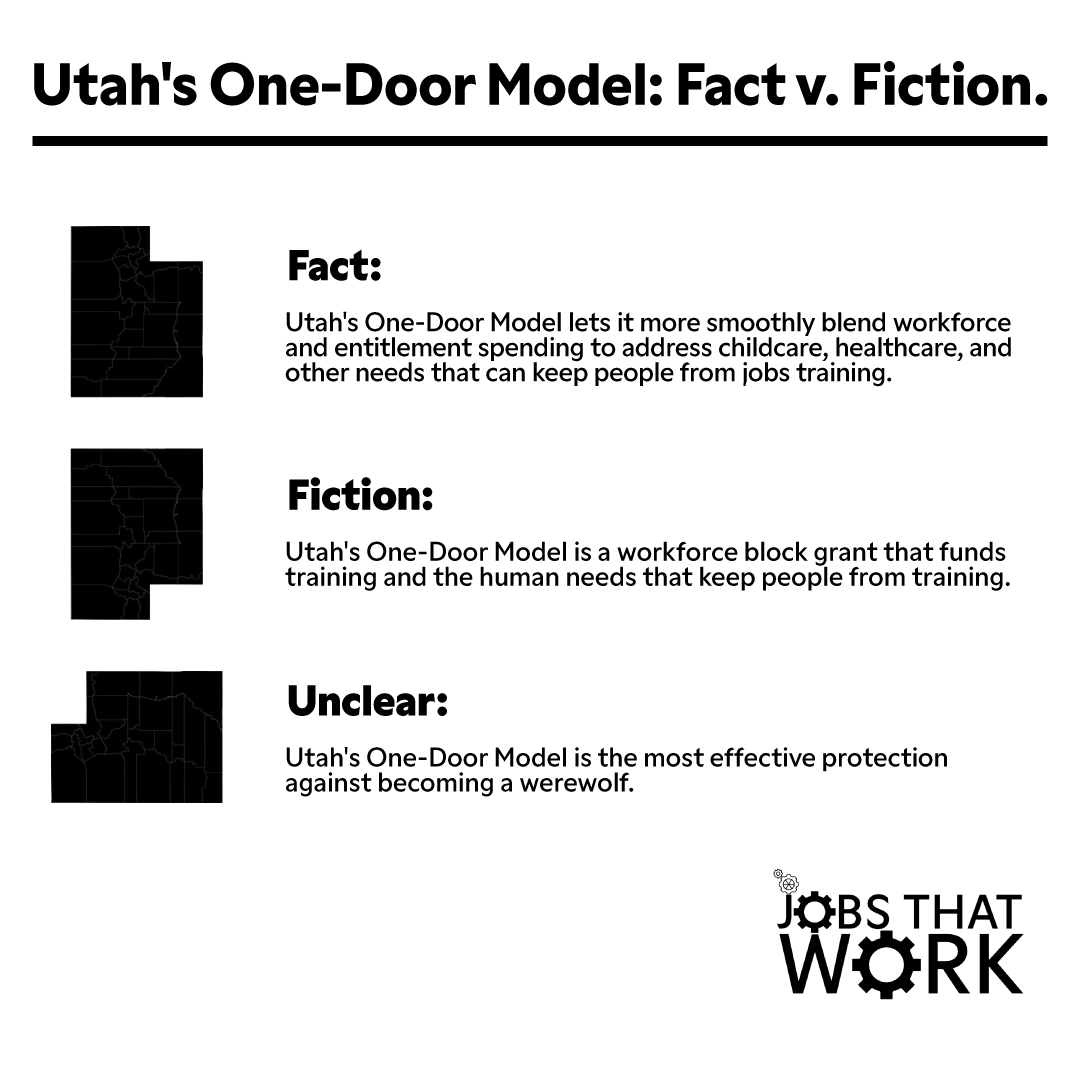Utah has good workforce lessons. They may not be the ones you've heard about.
The false struggle between workforce and ‘welfare.’
Check out my Labor Day sale on annual subscriptions.
It’s been a tough year for organizations reliant on federal workforce dollars, and more changes could be on the horizon. In my recent reader survey, I heard from several of you let me know that you would like to sign up for JOBS THAT WORK, but can’t because of organizational spending limits.
To help, through Labor Day, I’m offering a sale on annual subscriptions for subscribers with .org, .gov, and .edu email addresses. You can save 30% on individual subscriptions and 50% per user on annual subscriptions. To take advantage of the sale, please fill out the form connected to the button below.
The issue
Utah’s approach to workforce and entitlement programs has captured the imagination of some policymakers. They’re missing its real lessons.
Explain.
Congress is about to leak back into D.C., starting what could be a consequential month on the future of workforce development in the United States.
The Trump Administration wants to get rid of the current workforce system and replace it with what I call a “blob grant”—eliminating all federal workforce infrastructure and replacing it with one state-by-state grant that cuts “bloat” while somehow fixing the consequences of chronic workforce underfunding at the same time.
There are signals that Republicans in Congress don’t think that the Trump Administration’s budget—which takes an initial step toward that blob grant—is passable in either chamber. What I have heard suggests we’re more likely to get the status quo in the near term—maybe with a financial haircut—until the Republican majorities and the White House can work out a full replacement for the Workforce Innovation and Opportunity Act, America’s main source of workforce dollars.
Regardless of the outcome, something you are liable to hear about is Utah’s “One-Door Model.” Utah’s way of doing workforce and entitlement programs together is both an interesting piece of bureaucratic trivia and an idea that has enthralled the conservative side of the workforce policy conversation.
Conservative thinktanks have credited it with boosting Utah’s GDP and reframing the nature of work in the state. I understand that some Hill staff claim that Utah’s system approach justifies slashing American workforce development and getting behind the Trump blob grant plan. I wouldn’t be surprised if you told me that the Manhattan Institute put out a report saying the One-Door Model has made all Utahns 10 percent prettier, smarter, and better smelling.
I don’t know about all that, but there are interesting lessons from the Utah model that I think get missed because of the conservative focus on its bureaucratic particularities. Because Utah’s system hacks the artificial barrier between “welfare” and workforce training—and in doing so, creates a better-shaped version of workforce development that Congress has been resistant to paying for.
Here’s the door.
The One-Door Model in three bullets and four sentences:
Utah, with the goal of moving someone off entitlements and into the workforce, routes workers to both the training they need and the social services they need to get to that training, like childcare and other help.
That’s different from other states, where workforce money and entitlements can be split among multiple different state and local agencies that struggle to coordinate with each other.
WIOA can pay for services like childcare, healthcare, and more, but not very much. It also directs workers to go to the entitlement agencies first, which can be a weekslong—if not monthslong—runaround for workers to get what they need to just get to training.
I don’t like flat work requirements for safety net programs, and you can read about why in the notes below.1 But in broadstrokes, Utah’s system is kind of how all federal workforce programs should work anyway. As I have written about before, you have to first address human needs like how someone is physically getting to the training—or if they need someone to take care of their kids—to successfully get them into a better job.
In the recent past, some in Congress have advocated against expanding supportive services like childcare and transportation due to political concerns about making free, government-funded workforce into “welfare.” Similarly, Utah’s One-Door Model also has conservative critics who think it’s too good at getting people onto the healthcare they need.
Going flat.
The usual explanation for why Utah is better at helping the whole of a worker is its flat, state-only structure that doesn’t involve getting money to the street through local workforce boards, federally mandated structures for spending jobs cash on the ground. Utah’s structure is legal because it adopted it before the passage of 1998’s Workforce Investment Act, the predecessor to WIOA. WIA and WIOA both prohibit centralization of workforce and entitlement dollars in ways supporters insist are essential to One Door.
That means there’s plenty of red meat for all types of conservatives in the One-Door Model. For the small-government Republican, the Utah approach looks like evidence in support of slashing away at bureaucracy that creates more staff and slow down the effectiveness of money. For the more MAGA-minded, it looks like a way to keep money from blue areas of red states that might spend on stuff that Republicans don’t like.
Yet, I’m not sure the assembly of the bureaucracy matters quite so much as recognizing that these systems are meant to help people—and that help can’t just be telling them where to go get a job. Too often, I have seen workforce programs treated as weigh stations that shuffle people around from disinterested office to disinterested office until they reach outcomes, not results. I’m doubtful a flattened organization chart, alone, can wipe away poor organizational views of people with low—or no—incomes and replace it with the effort needed to actually help them get ahead.
“It’s all about, you know, how do we serve the community in the most efficient and best way?” said Melisa Stark, Utah’s former Apprenticeship Commissioner who joined Utah’s workforce efforts around the time it implemented One Door. “And I think we've done a pretty good job of that here.”
So what should we do about it?
If it’s not clear, I don’t think that Utah offers a massive pile of evidence for ditching local workforce boards and giving all control to states, which has been at least an undercurrent in each evolution of the Trump blob grant plan. Yeah, Utah offers a more streamlined way of getting all the entitlements pointed toward work. However, I didn’t see anything in my research that said state or local officials in non-Utah states can’t, you know, call each other and figure out how to do stuff better even if they don’t have the same boss.2
Also, as with anywhere, what works for Utah is flavored by local conditions that don’t apply everywhere. For example, 90 percent of Utah’s population lives within a two-and-a-half-hour drive. It’s a whole lot easier to keep people coordinated when they’re not that far down the road. That’s not possible in, say, Texas.
Instead, if I wanted to learn from what Utah was doing, I would focus on how it coordinates around workforce programs being part of “welfare” and that being a good thing.
If WIOA stinks at helping people get to work by giving them a hand with transportation and childcare because Congress doesn’t want it to become “welfare,” that’s more than a little silly and counterproductive. Either those human needs get solved, or people don’t get to work. Full stop.
I don’t love every aspect of the Utah approach, but at least it opens a door for doing the human part of workforce better. And to some degree, I wonder whether the conservative focus on the peculiarity of Utah’s workforce bureaucracy is a way of rationalizing that more logical way of doing workforce in language that still fits within anti-welfare politics.
Still, even Utah’s “good welfare” can’t beat the reality of how little we spend on workforce and the harsh controls on who can touch the money. Stark, who is very proud of her work in the state, said that the system in Utah still buckles under the weight of too much need, not enough resources, and an inability to provide the longer-term help that can move people into more sustainable solutions like apprenticeships.
“The ones that fall through the cracks are the ones that are just over the income limits” to qualify for services, she said. “Yet they're not making enough to really support their families.”
Card subject to change.
I’m keeping an eye on several things percolating around the Trump Administration and its workforce plans. According to one of the April executive orders, Thursday was the deadline for the Department of Labor to produce something on AI and apprenticeship. That, plus it being Labor Day, would imply this is how we’ll find out what’s happening with the $200 million or so in missing apprenticeship cash. But we’re well beyond my answer being a long line of shrug emojis, so, we’ll see.
I’m also keeping an eye out for a spending bill from the House on labor, education, and health programs. I make no bets on anything these days, and it’ll be interesting to see how things shake out and the effect it has on the Administration’s current spending and lack thereof.
Speaking of which, on Friday, if we haven’t seen a flood of new workforce grants and contracts, I think it’s time to talk about the idea of pocket rescissions and what recourse anyone has if the Trump Administration isn’t willing to spend workforce money on projects for things it likes. I’m only getting more confused by what I’m seeing and what I’m not seeing the deeper I dig in, so… look forward to that.
Next Tuesday, I’ll be back here to talk about what I think is the biggest issue holding back the American workforce. Seriously.
So… you grow up for a time on Social Security death benefits due to your mom having untreated post-traumatic stress disorder from her partner’s death, and it turns out you acquire strong opinions on whether it’s a good idea for a person like that to be pushed back into the world of work to keep the public money making their life vaguely functional.
Could a system like Utah’s helped my mom get back on her feet sooner through behavioral health services? Maybe, maybe not. I tend to think that you can’t rush the process of healing in a situation like that without causing more damage. I do think it’s useful to have an endgoal toward self-sufficiency and helping people on entitlements get back into the workforce—if that’s help they really do need, and it’s actual help, not prodding.
Catching people when they need help is why the social safety net exists. I think it’s counterproductive the more you make this about getting people off entitlement programs to save money for the government or as a perpetuation of stigma against those helped by safety net programs.
I’m sure there are plenty of catches in that last sentence that Utah can navigate better because it has everybody under one metaphorical roof, including things like the sharing of personal information. Even still, I don’t think it’s impossible for, say, someone in Head Start office to tell the local workforce board that one of its programs only offers care from 9 a.m. to 2 p.m. and might not be a great fit for a single mom training at 3 p.m. And in 2025, I have seen even better—and more real-time—technological solutions than that.




